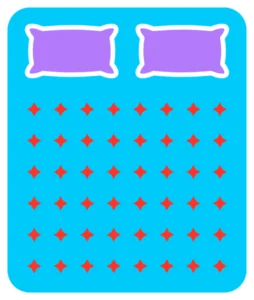
Bed Sizes UK: Bed and Mattress Size Guide
An overview of all the different UK bed and mattress sizes and how to choose the right one for you and your needs.
UK bed and mattress sizes chart
| UK BED / MATTRESS SIZES | IMPERIAL AND METRIC DIMENSIONS |
| Small Single Bed | 2’6″ x 6’3″ (75 x 190cm) |
| Single Bed | 3’ x 6’3″ (90 x 190cm) |
| Small Double Bed | 4’ x 6’3″ (120 x 190cm) |
| Double Bed | 4’6″ x 6’3″ (135 x 190cm) |
| King Size Bed | 5′ x 6’6″ (150 x 200cm) |
| Super King Bed | 6’ x 6’6″ (180 x 200cm) |

Small Single Bed
2’6″ x 6’3″ (75 x 190cm)
What size is a small single bed and mattress?
A small single bed size measures 75cm wide and 190cm long.
In imperial dimensions, this is 2 feet 6 inches wide and 6 feet 3 inches long.
Who are small single beds suitable for?
Small single beds and mattresses are mainly suited for younger children. They are a good ‘first’ bed when moving from a cot.

Single Bed
3’ x 6’3″ (90 x 190cm)
What size is a single bed and mattress?
A standard single mattress size measures 90cm wide and 190cm long.
In imperial dimensions, this is 3 feet wide and 6 feet 3 inches long.
Who are single beds suitable for?
Single beds and mattresses are suitable for both children and adults. They are the most common size to be used as a children’s bed, but they are wide enough to fit a single adult sleeper.

Small Double Bed
4’ x 6’3″ (120 x 190cm)
What size is a small double bed and mattress?
A small double bed size measures 120cm wide and 190cm long.
In imperial dimensions, this is 4 feet wide and 6 feet 3 inches long.
Who are small double beds suitable for?
Small double beds and mattresses are wider than a single bed but smaller than a double. They offer plenty of room for a single adult but can be a little cramped with two. They are ideal for guestrooms or smaller bedrooms where space is at a premium.
Small double beds are also known as a ‘Queen size bed’ or ‘Three quarter’.

Double Bed
4’6″ x 6’3″ (135 x 190cm)
What size is a double bed and mattress?
A double bed size measures 135cm wide and 190cm long.
In imperial dimensions, this is 4 feet 6 inches wide and 6 feet 3 inches long.
Who are double beds suitable for?
Double beds and mattresses are designed to fit two adults comfortably. But bear in mind, a standard double bed gives each person just 2 feet 3 inches of space – the same space a baby has in a cot!

King Size Bed
5′ x 6’6″ (150 x 200cm)
What size is a king size bed and mattress?
King size bed dimensions are 150cm wide and 200cm long.
In imperial dimensions, this is 5 feet wide and 6 feet 6 inches long.
Who are king size beds suitable for?
King size beds are both longer and wider than a standard double, so they can provide an extra level of comfort for two adults. The available space in the bedroom should be considered.

Super King Size Bed
6’ x 6’6″ (180 x 200cm)
What size is a super king size bed and mattress?
The super king bed size measures 180cm wide and 200cm.
In imperial dimensions, this is 6 feet wide and 6 feet 6 inches long.
Who are super king size beds suitable for?
Super king size beds are the same length but wider than a king size, so they provide extra space for those who may require it, or those wanting a little extra luxury. Super king size are only suitable for larger bedrooms.

How should you choose what size bed is right for you?
There are so many things to consider when you’re buying a bed or mattress – not least what size you should opt for.
If you’re buying a bed for two adults then there are a number of things that you need to consider.
Length of bed
Firstly, the length. We advise buying one that’s at least 10cm longer than the tallest person. The last thing you want is for your feet to be dangling over the end of the mattress or you have to curl your legs up.
The length of a standard UK double bed is only 190cm (6’3”), so anyone taller than 5’11” (180cm) should really opt for one that is 200cm (6’6”) in length. A UK king-size bed measures 200cm in length, as does a super-king size, so either of these options would be preferable.
If you’re a particularly tall person, some bed manufacturers make products that are 215cm (7’0”) in length. Alternatively, you could choose to purchase a ‘bed extender’ type product. Use our Product Finder to find brands that make extra long beds.
Width of bed
The majority of British couples still sleep in a standard double size bed which is only 135cm (4’6”) wide. This provides each user with just 67.5cm or about 2’3” of space each which is the same as we give a baby in a cot! It’s certainly very cosy for two people and with so little room to move, you’re more likely to disturb your partner every time you change position, resulting in a poor night’s sleep. However, some couples prefer to sleep in close proximity to each other, claiming that it improves intimacy compared to sleeping in a much bigger bed where you literally have to go searching for your partner!
Although two people can share a small double (120cm or 4ft wide) bed, we would only suggest this size as an occasional bed for two people. This size would be more suitable for a single user, especially with UK studies showing that we’re getting bigger and heavier due to our diet and sedentary lifestyles!
So with partner disturbance a major cause of poor sleep, buying a bigger bed should result in a better night’s sleep. When trying out a bed for size, you and your partner should lie next to each other on your backs. Put your hands behind your head with your elbows sticking out. If your elbows don’t touch your partners’ then you have enough space to sleep comfortably.
Use our Product Finder to find brands that make extra-wide beds.
Can sleeping in separate beds improve your sleep?
The number of couples sleeping in separate beds is on the increase. In the Sleep Council’s Great British Bedtime Report from 2017, 12% said they slept apart compared to only 8% in 2013. Nearly a quarter of couples also reported sleeping apart at least some of the time. If you’re one of those who prefer to sleep in your own bed but still wish to be in the same room as your partner, the most popular option is the standard single bed which measures 90cm or 3ft wide, giving you plenty of room to get comfortable.
If you have a large bedroom, you could consider buying two single beds or even opt for a zip and link set where the two beds can be joined together to form a super king size. Having said that, many modern houses tend to have smaller bedrooms as the demand for 4 or 5-bedroomed properties results in a squeeze on room sizes upstairs. So, for many couples, a super king-size bed is out of the question.
Here are just ten reasons why a bigger bed is better:
1
Because a standard double bed (135cm/4ft 6in) gives each person just 2ft 3in of space – the same as we give a baby in a cot. Now how squeezed is that?
2
Ergonomic studies show that couples sleep better in a bigger bed. Before the trials only 15% said they would buy a larger than standard bed. Afterwards 50% said they would. (Ergonomic pilot study by the National Bed Federation, 1995.)
3
Because you spend a third of your life in bed – by the time we are 50 we’ll each have spent some 16 years in bed. If you are going to spend all that time there, why take the trip to dreamland in tourist class when you can go first class?
4
Because it doesn’t necessarily cost a whole heap more to move up a size. Over seven years, every £100 spent on a new bed costs just 3.9p per night.
5
Because 16 other countries can’t be wrong! That’s how many boast bigger average bed sizes than Britain. Top of the league are Belgium, Greece, Holland, Iceland, Finland and Switzerland where most people sleep in a roomy 160cm by 200cm bed. By contrast we Brits still buy more 135cm by 190cm beds.
6
Because you spend as much as you can afford on the best possible house, holiday, car, kitchen, TV and sound system. So why so stingy when it comes to buying a bigger bed?
7
Because you wouldn’t want to get left behind! Although two-thirds of us still opt for the standard size, larger beds are becoming ever more popular among those with the bedroom space to take one: 33% of double divan and bedstead sales are now 5ft (king-size) or larger. (GfK NOP Consumer Scope Beds and Mattresses Market Monitor, December 2010).
8
Because the average person wriggles and turns some 60 to 70 times a night – so you want to put as much space between you and your mate as possible to reduce the disturbance factor.
9
Because you may not be as young as you were – or as slim! A 2014 report from the World Health Organisation said that 28.1% of adults in the UK were classified as obese in which case the ‘two in a 4 ft 6″ scenario’ could be putting a severe strain on your relationship.
10
Because once you’ve slept in a king-size, you’ll never want to be a second-class sleeper again!

